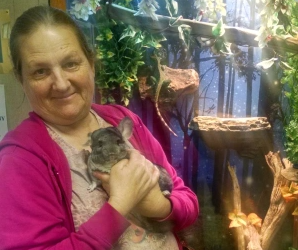Chinchilla Behavior: Socializing Chinchillas
Chinchillas: those adorable, silky-soft creatures are a bit of a mystery to the general public. Are they mice? Are they rabbits? What exactly ARE chinchillas?
Chinchillas are from the rodent family and are slightly larger than an average ground squirrel. They live high up on the Andes Mountains, in South America, and have extremely soft, dense fur to keep them warm at high altitudes. It’s that very adaptation which make them great animal ambassadors for children’s education programs. They are living examples of how, over time, animals have changed physically and behaviorally, to thrive in a specific environment. Chinchillas have also been over-hunted for their velvety, warm fur. They are living, breathing specimens that help the Center educate our younger generation on why it is important to protect animals, both in our backyards and in the wild.
Due to their innate shy nature, chinchillas may not be a natural selection to be an animal ambassador in a children’s education program, but staff at Helen Woodward Animal Center have found that with time, patience, and a lot of TLC, chinchillas can become well-socialized with adults and children! And we’ll show you how!
Cindy, The Chinchilla Whisperer

About a year ago, Center staff recognized its need for a new volunteer position – chinchilla whisperers! The recent addition of chinchilla animal ambassadors revealed that though the fluffy critters could become animal all-stars, they were in need of some socializing first. Cindy Mayo was one of the original volunteers to embark on this new idea, giving feedback as she went while we sorted out any kinks through trial and error. It’s probably one of the strangest positions available, where we tell people in training to just talk for two hours straight while sitting by an enclosure with a treat in their hand. It seems simple enough until you realize you’re in a corner having a conversation with yourself, but that never stopped Cindy! She knew consistency was key to success and made a point to come in extra days if she missed her shift. She always has reading material at the ready to get the chinchillas accustomed to human presence. Although she says they’re sometimes asleep her whole shift, she’s had some of the best moments with them where they climb all over her and enjoy getting pet by her; something not even the daily chinchilla caretakers get to experience!
Cindy is meticulous with planning every interaction with the chinchillas. She makes the most out of every “Treat Opportunity” (because we simply can’t give treats all day long, then we’d have very unhealthy chinchillas!) and will strategically place her fingers so that the chinchillas will attribute the joy of treats with soft touches from human hands.
Chinchilla Behavior Guide
With Cindy’s feedback, we have developed a Chinchilla Socialization Guide that is followed each and every time someone interacts with the chinchillas. It is important to remember that progress can be easily lost if rushed too quickly. If the chinchilla seems uncomfortable with the next step you’ve taken, back down to the previous one to rebuild the trust before attempting to move forward. Just like when we learn, we have to take small strides to reach the end goal.
Phase One – Introduction
Begin by being a presence outside of the chinchilla’s cage. Talk to it in a calm, soothing voice. (Reading a book out loud works well!) Spend your time offering a treat through the cage bars.
Once the chinchilla readily approaches the side of the cage when a human walks over and takes treats easily through the bars, move onto Phase Two and stop with feeding through the bars as continuing to feed through the bars will create a bad habit where the chinchilla associates anything coming through the cage is food, even if it isn’t!
Tip: Move slowly and be patient during this phase, because this is the first step it can be one of the hardest.
Phase Two – Opening The Door
Open the door of the chinchilla’s cage, moving slowly and talking to it in a calm, soothing voice. Place a treat in the cage, nearer to you and the door, but keep your hands in front of you/at your sides. Once the chinchilla has taken the treat, slowly retreat and close the door. Repeat.
As you progress, move the treat closer and closer to you until the chinchilla is taking it right next to you. Once it’s doing that readily and approaches you when you open the cage door, you’re ready to move onto Phase Three.
Explaining Chinchilla Training Phases
Phase Three – Getting To Know You
Open the door of the chinchilla’s cage, moving slowly and talking to it in a calm, soothing voice. Place your hand inside the cage, fingers together and palm up, with a treat in your palm. Once the chinchilla has taken the treat, slowly retreat and close the door. Repeat.
As you progress, move the treat on your hand closer and closer to your body/cage door until the chinchilla is taking it right next to you and is lingering on your hand. Once it’s doing that readily and approaches you when you open the cage door, you’re ready to move onto Phase Four.
Phase Four – Petting Is Positive
Open the door of the chinchilla’s cage, moving slowly and talking to it in a calm, soothing voice. Place your hand inside the cage, fingers together and palm up, with a treat in your palm. As the chinchilla comes to take the treat, slowly use a finger from your other hand to pet it on its head/back. Be careful not to touch the whiskers, they’re ticklish! Once the chinchilla has finished the treat, slowly retreat and close the door. Repeat.
Start with only a single stroke of petting or two, moving onto longer petting as you progress. Once the chinchilla is readily approaching you when you open the cage door, taking treats from your hand while sitting there, and being pet while doing so, you’re ready to move onto Phase Five.
Tip: This is a good stage for a treat that takes a longer time for the chinchilla to eat, such as organic wild oats.
Phase Five – Picking Up
Open the door of the chinchilla’s cage, moving slowly and talking to it in a calm, soothing voice. Place your hand inside the cage, fingers together and palm up, with a treat in your palm. As the chinchilla comes to take the treat, slowly use your other hand, scooping it up into your chest. Offer the treat immediately as you’re holding it, and some slow, gentle petting. Once the chinchilla has finished the treat and is calm, slowly put it back in its cage and close the door. Repeat.
Tip: If you have the chase the chinchilla around the cage to pick it up, stop and go back to earlier phases.
Other Tips
- A chinchilla can only have 1-2 treats in a day, so they must be used wisely!
- It may help to break the treat in half so that the chinchilla can get a better smell of it – this also provides you with two rewards, instead of one.
- Become familiar with the chinchillas and their body language so that you can learn when they’re being pushed too far. The chinchillas are defensive animals, not aggressive ones, so they only react out of fear and would much rather run away than fight.
- Signs of stress are: rapid breathing, teeth chattering, vocalizing, fur loss, attempts of biting, whites of eyes exposed.
Success! Holding a chinchilla!
Chinchilla Socialization Success
Through Cindy’s thorough taming, the chinchillas now lead happier lives, with noticeable differences in their behavior and appreciation of handling. The days when she isn’t there, we know the chinchillas miss her because they sit expectantly by their enclosure doors for a while. We couldn’t have made so much progress if not for the helpful and detailed work of Cindy!
If you try out our guide, we’d love feedback on your progress! Leave a comment, email us at social at animalcenter.org or post a photo on Facebook to show us. Thanks for reading!





